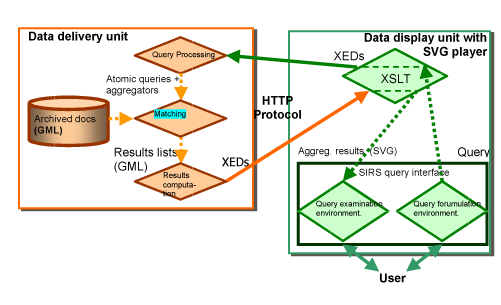|
|||
Extension of Electronic Documents to enable Server-Independent Architecturesby Paola Carrara, Giuseppe Fresta, Daniela Poggioli An eXtended Electronic Document (XED) is an XML document which aggregates data, templates, transformation rules and manipulation tools. It can be used to design complex systems on the Internet in a server-independent way, modifying the traditional asymmetry between the logical units of Web architecture. The two dialoguing units of traditional Web architecture are a data delivery unit, which is usually in charge of computing activities, and a data display unit, which requests, receives and browses information. JavaTM opened the way to a new concept of the Web, by sharing/ distributing computation on both sides of the Web architecture, but it delivers binary code which is not extensible and can be only executed. XML (eXtended Markup Language) makes it possible to exchange open and textual information: It defines structured text files which can be manipulated by programming languages acting at any component of the Internet architecture. XML tags can be freely defined to reflect the semantics of any application universe and the structure of the documents to be dealt with. One example is the Geographic Markup Language (GML), defined by the OpenGIS Consortium to provide a common model and common format for the description and expression of geographic entities. Recent literature addresses the relationship between semantically-rich Markup Languages, such as GML or GraphML, and SVG (Scalable Vector Graphics), the W3C recommendation for vector graphics. Architectures have been presented in which information is described and managed at the server side by the language(s) suitable for the data model(s) under consideration, and is then translated into a graphic-oriented language at the browser side for visualisation and user interaction purposes. These approaches maintain the traditional asymmetry between the units of the Internet architectures, and make it impossible to conceive application environments that can manage, manipulate or even exchange information indifferently at either of the two logical units of the network. To overcome this situation, we propose to evolve the concept of electronic document to an eXtended Electronic Document (XED), which is an information aggregation gathering together data items, templates for their representation, and tools for their description/manipulation. An XED document is an XML-document consisting of:
Original data/template fragments can be stored in different repositories, and be compliant with various data models, formats, languages, etc. They can be enriched by meta-information to account for different aspects such as semantics, quality, validity, languages, access rules, etc. The XED can be exchanged between different Internet components, transformed and manipulated at any network node; the entire XED, or its components, can be searched for retrieval or filtering purposes, and aggregation can thus be dynamic. An XED should contain all the instructions necessary for its rendering, manipulation and/or storage, by the preferred Internet data displayer such as a Web browser, a mobile or a sound/voice rendering device. Our proposal strengthens the possibility of reusing data in different situations and purposes as we do not conceive XEDs as ‘static’ entities, created by the designer. For example, one ‘primitive’ XED can be used both by a well-defined group of end users (such as Italian students using a Web browser) and intermediate users who have to enrich it with more information (for instance, translators who must add the English version of the data or programmers who must unite transformations and rules to allow visualisation on a PDA). In this way, it is possible to design complex systems on the Internet as chains of computing activities on specific XEDs: each activity transforms the document (the data, the templates and/or the tools) and prepares it for a successive activity to be performed by other users at any Internet component. The designer can statically assign the different activities on the basis of criteria such as performance, data dimensions, available hardware platforms, etc.; a dynamic assignment can be also made on the basis of the document status, user profiles, etc. We tested these ideas, taking as case study, an Information Retrieval system for geographic information to be implemented on the Web. The system design is performed through distinct steps, ie: a) analysis of the computational activities to be performed, and the data and interaction they require;
Teh Figure illustrates the result of steps a) and b), ie the activities we identified (only macro-activities are shown), and the assignment to the units where users can formulate queries and look for results. The criterion adopted was the level of interaction with the users: some activities, such as query processing, matching between queries and documents, and the first aggregation of result list(s) are delegated to the data delivery unit, as they do not require direct user manipulation. At this step, data are described by GML. The data display and interaction activities (mainly query formulation and results examination) are included in the display unit and are executed directly on the transformed SVG version of the documents. Therefore the architecture also includes environments to perform the language transformations. The XEDs, delivered between the units by a plain HTTP protocol, are not limited to the GML data description but also contain templates and code to guide presentation, and the necessary interaction tools. Please contact: Giuseppe Fresta, ISTI-CNR |
|||



